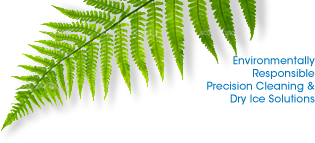
Dry Ice Blasting: The Green Clean
A safe alternative for you and the environment
Cold Jet’s dry ice cleaning equipment provides a superior clean using the dry ice made from reclaimed CO² — the same food-grade media as found in carbonated beverages. Dry ice has been recognized by the EPA, FDA and USDA as an acceptable material in cleaning methods. Completely safe and non-toxic, dry ice does not produce or add CO² to the atmosphere – which is why using dry ice is considered to be “carbon neutral” and environmentally responsible. It produces no secondary waste stream, eliminating the added cost of secondary waste collection, treatment and disposal. Dry ice cleaning also eliminates harmful ozone depleting chemicals, providing a healthier work environment by eliminating exposure to Volatile Organic Compounds. It’s completely green from start to finish.
As the industry experts in dry ice technology solutions, Cold Jet can provide guidance on the best methods to address site characteristics and safety concerns. Our commitment to customer satisfaction keeps us on the leading edge, always delivering a clean like you’ve never seen before.
Dry ice blasting is clean and safe
- Dry ice has been approved by the EPA, FDA and USDA as an acceptable material in cleaning methods.
- For food processors, dry ice blasting has been documented by the Food Standards Agency to effectively decontaminate surfaces of Salmonella, E. coli, and Listeria.
- Dry ice blasting does not release harmful gases into the atmosphere.
- Dry ice blasting does not generate secondary waste.
- Dry ice blasting is safe and nontoxic (once pellets impact the surface they dissipate).
- Dry ice blasting reduces or eliminates employee exposure to (and corporate liability from) the use of dangerous chemical cleaning agents.
Environmentally Responsible
In addition to being clean and safe, it is also important to remember that dry ice is obtained as a by-product of other industrial processes – i.e. it is made from reclaimed CO². It does not produce CO² or add CO² to the atmosphere and therefore does not contribute to the greenhouse effect. Dry ice blasting is truly, and completely, environmentally responsible.
Other cleaning methods can be toxic
- When using solid grit media or water for cleaning hazardous materials, the cleaning medium also becomes hazardous, requiring special handling, disposal and regulatory reporting. Dry ice creates none of these waste stream additions.
- Sand, soda, or water blasting can create downstream contamination that affects surrounding installations.
- Soda blasting can kill surrounding vegetation.
- Chemical and solvent cleaning methods are toxic, which creates toxic waste requiring disposal.
- Workers are exposed to potentially harmful substances through the use of chemicals and solvents.



